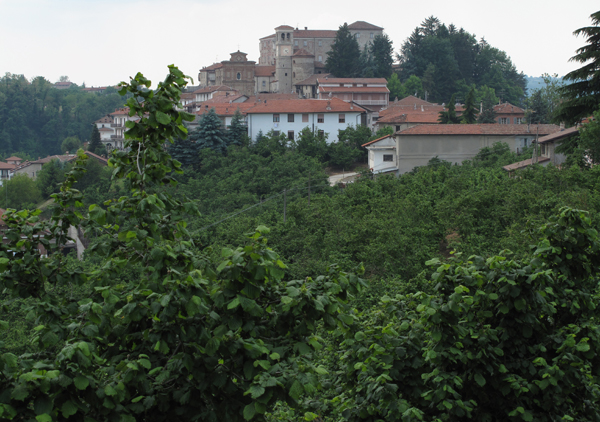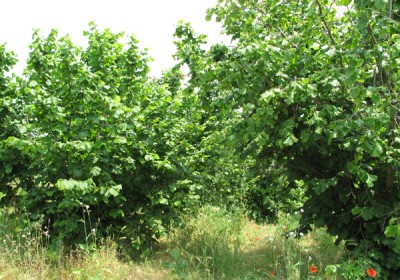
Tonda Gentile delle Langhe excels in every objective measure of hazelnut quality for confectionery. But, subjectively, do the nuts taste better? It’s not difficult to find experienced food writers and chefs who insist they do.
Jeffrey Steingarten describes Piedmont hazelnuts as “the finest…you can eat” (1). Pastry chef Gina DePalma describes them as “the greatest hazelnuts in the world” (2). Pastry chef and food writer David Lebovitz writes, “I do not like to speak in superlatives, since I think if you’re gonna say something, you’d better really, really mean it. So when I say that the hazelnuts from Piedmont are really the best I’ve ever tasted—believe it” (3).

Tonda Gentile delle Langhe.
Corby Kummer—after directly comparing TGL with hazelnuts from Oregon (cv. Barcelona), Turkey (probably cv. Tombul), and Viterbo (probably cv. Tonda Gentile Romana)—concludes that, “In my taste comparisons I understood why Piedmont hazelnuts have retained their reputation. The flavor of Viterbese hazelnuts is very fine, but that of Piedmont nuts is more intense…. Turkish and Oregon nuts, I found, had the highest proportion of wood flavor, Piedmont the highest proportion of hazelnut flavor” (4).
Many well-regarded chocolatiers and chocolate makers around the world insist on Piedmont hazelnuts, including Michel Cluizel, François Pralus, Pierre Hermé, Debauve & Gallais, William Curley, Michael Recchiuti, et al. Even within Italy, Tuscan chocolate maker Amedei uses Tonda Gentile delle Langhe hazelnuts from Piedmont, rather than Tonda Gentile Romana from the nearer province of Viterbo. TGL are, of course, sine qua non for respected chocolatiers, chocolate makers, pastry chefs, gelatieri, and chefs in Piedmont.
Even if we assume a degree of “suggestibility” in the widespread acclaim of Piedmont hazelnuts among chefs and food writers, it is much harder to discount the cultivar’s reputation among scientists specializing in hazelnuts.
Tombesi and Limongelli state unequivocally that “Tonda Gentile delle Langhe remains the reference cultivar for quality” (5). In developing new cultivars at Oregon State University—which operates the largest hazelnut breeding program in the world—scientists have used Tonda Gentile delle Langhe and Tonda di Giffoni as the benchmarks for excellence of kernel quality (6). Shawn Mehlenbacher of OSU has written that, “For the kernel market, the Italian cultivars Tonda Gentile delle Langhe, Tonda Romana, and Tonda di Giffoni…provide standards against which advanced selections are compared” (7).

Unripened Tonda Gentile delle Langhe kernel.
In a 2002 sensory evaluation comparison of the three leading Italian cultivars and eight crosses, TGL was the only one to receive an “Excellent,” with Tonda di Giffoni and Tonda Gentile Romana rating as “Good” (8). A 2003 panel testing of six Italian cultivars (plus the Turkish Tombul) also resulted in TGL scoring the highest for kernel quality (9). A 2008 panel testing of the same seven cultivars saw TGL again rank highest in the sensory analysis, with panelists scoring the kernels highly for sweetness, intensity of flavor and aroma, and low bitterness and astringency (10).
The world hazelnut kernel market also provides evidence of TGL’s quality and desirability. Unlike the output of other countries, where pricing is based on factors such as delivery timing, kernel percentages, and size, the three leading Italian cultivars command a premium for flavor, aroma, and texture. Tonda di Giffoni (Campania) and Tonda Gentile Romana (Lazio) get a 25% bump in price for quality, while “Tonda Gentile delle Langhe from Piemonte in northern Italy commands a 50% premium” (11).
The organoleptic excellence of Tonda Gentile delle Langhe is so widely recognized—by food writers, by scientists, and in the world hazelnut market—that the Piedmontese can convincingly argue that their hazelnuts really are the best in the world.
Notes:
1. Steingarten, Jeffrey. The Man Who Ate Everything. Vintage Books. New York. 1998. P. 250.
2. DePalma, Gina. “Snapshots from Italy: Crema di Gianduja,” Serious Eats blog (http://www.seriouseats.com/2008/02/snapshots-from-italy-crema-di-gianduja.html), February 26, 2008.
3. Lebovitz, David. “Back to Torino,” David Lebovitz blog (http://www.davidlebovitz.com/archives/2008/11/back_to_torino.html), November 11, 2008.
4. Kummer, Corby. “Nuts I Love,” The Atlantic Monthly. Vol. 277, No. 4, April 1996. P. 110.
5. Tombesi, A., and F. Limongelli. “Varietà e Miglioramento Genetico del Nocciolo.” 2° Convegno Nazionale sul Nocciolo. Giffoni Valle Piana. 2002. P. 11.
6. Mehlenbacher, Shawn A., David C. Smith, and Rebecca L. McCluskey. “‘Sacajawea’ Hazelnut,” HortScience, Vol. 43(1), February 2008. P. 255.
7. Mehlenbacher, Shawn A. “Genetic Improvement of the Hazelnut,” Proceedings of the III International Congress on Hazelnut. Acta Horticulturae: 351. 1992. P. 24.
8. Farinelli, D., M. Boco, and A. Tombesi. “Ulteriore Valutazione di Genotipi di Nocciolo (C. avellana) Ottenuti Mediante Incrocio tra le cv. Tonda Romana e Tonda di Giffoni.” 2° Convegno Nazionale sul Nocciolo. Giffoni Valle Piana. 2002. P. 162.
9. Cristofori, Valerio. Fattori di Qualità della Nocciola. Tesi di Dottorato di Ricerca. Università degli Studi Tuscia di Viterbo, Dipartimento di Produzione Vegetale, Sezione Ortofloroarboricoltura. 2005. Pp. 144-8.
10. Cristofori, V., S. Ferramondo, G. Bertazza, and C. Bignami. “Nut Quality and Sensory Evaluation of Hazelnut Cultivars,” Proceedings of the Seventh International Congress on Hazelnut. Acta Horticulturae: 845. 2009. Pp. 659-63. For the testing, “Roasted nuts of the seven cultivars were examined for their sensory profile by a panel including 15 members of the Department staff and students; they had previously received some training on sensory evaluation of nuts for the understanding of the meaning of the attributes and for the assessment of sweet taste and aroma intensity. The evaluation was carried out in a room equipped with individual sites and with white incandescent light. Anonymous samples were submitted to the panelists, who were invited to drink a sip of water and eat some unsalted crackers between samples, in order to avoid tiring effects. The most important visual, olfactory and taste descriptors were assessed: color, roundness, shape regularity, aspect, peelability, aroma intensity and pleasantness, rancid, vegetable, woody, crispness, hardness, taste intensity, sweetness, oily, astringency and bitterness. The panelists were also requested to express the level of general appreciation.”
11. Mehlenbacher, Smith, & McCluskey, 256.
